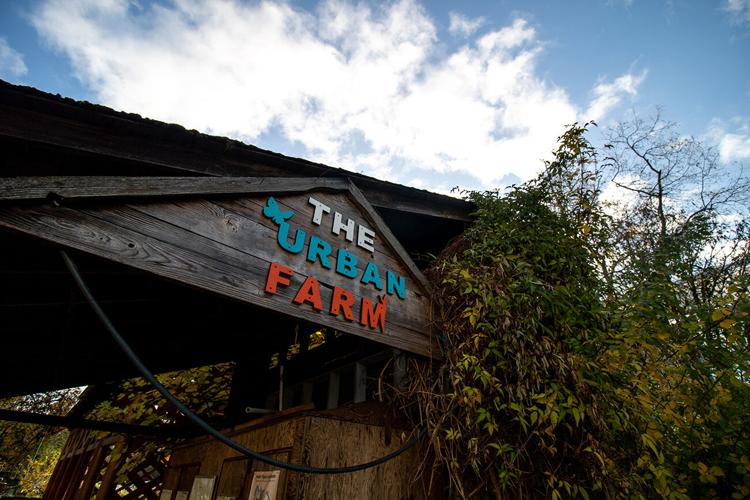Like almost every aspect of life, the University of Oregon’s urban farm is working to adapt to the COVID-19 pandemic. As a space that works to foster community, the farm has made a push to continue in-person activities.
“When COVID first came right before March, at the end of the winter term, we were much stricter, because we didn’t know as much about COVID,” Harper Keeler, the farm’s program director, said. Based on the hands-on nature of the class — 40% of student grades have historically been based on showing up at the farm and participating in class — the urban farm course wasn’t feasible in a virtual format.
This meant that instead of offering the urban farm class over the summer, the group working at the farm was limited to Keeler, five team leaders and a handful of already-hired students on work study. Grace Youngblood, one of the students on work-study, said the farm’s summer situation was the most noticeable shift for her.
One of the problems they ran into was a lack of students taking the course to send home with the food they grew. As a result, the summer farm crew donated everything to the student food pantry twice a week, supporting food security on campus.

Urban Farm is offered as a class every term at the University of Oregon, allowing students to get hands-on experience with local food production. The University of Oregon's Urban Farm is a student and community led project that focuses on promoting sustainable food systems and community-based activism. (Will Geschke/Emerald)
While Keeler said he was proud of how much they were able to contribute to the UO community, he said the lack of students on the farm was a major loss. “It was really, really sad not to have students here,” he said. “The energy that the students bring to the farm is crucial.”
However, Keeler said the space the farm provided was especially important during the pandemic. “I started noticing, on numerous occasions, individuals just sitting there crying,” he said. “We’re all grieving. That was the day I decided: I’m not kicking anyone out of the garden.”
During fall term, things have turned around. Keeler has been able to teach two smaller classes on the farm with the help of his team leaders. Although they’re constantly sanitizing tools, maintaining social distancing and replacing the odd in-person class with a video assignment from the streaming platform Kanopy, the urban farm has found a way to proceed relatively unhindered.

The Urban Farm is home to a wide variety of plant life, and is also home to a number of bee hives. The University of Oregon's Urban Farm is a student and community led project that focuses on promoting sustainable food systems and community-based activism. (Will Geschke/Emerald)

Wheelbarrows rest against one another outside the Urban Farm's "Red Pole Circle", a central meeting location on the Urban Farm. The University of Oregon's Urban Farm is a student and community led project that focuses on promoting sustainable food systems and community-based activism. (Will Geschke/Emerald)
“It has been really sweet to have somewhere to go two days a week that isn’t just my desk in my room,” Jenna Rudolph, one of the students in the class, said. For Rudolph, spending time on the farm is a wonderful break from her otherwise-virtual class schedule. “Urban farm, it’s like you pull something from the ground,” she said, contrasting it with the less tangible process of completing work online, “and you have something in your hands that you’ve helped produce, which feels more gratifying.”
Eloise Parish Mueller, another student enrolled in the course, said it’s nice to be somewhere where she can tell everyone else is happy to be there, too.
“It feels really satisfying to work towards something together and to get to share food amongst one another,” Rudolph said. “I think that still builds community. But I think there are some limitations on how much socializing outside our little crews there is, because of COVID.”
Keeler pointed to Halloween as one of those limitations. Usually, this is a time when students get together to celebrate the Celtic holiday Samhain — a festival that honors the end of the harvest season and the beginning of the winter months — but Keeler had to tone down the event. Instead of a potluck, students gathered for socially-distanced apple cider and a talk about the significance of the day in relation to agricultural practices.

(Will Geschke/Emerald)
Keeler has set up other COVID-19-safe events, as well. He hosted a socially-distanced movie night for one of his First-year Interest Groups and a cocktail night for some of the graduate students in UO’s Landscape Architecture program. While the weather is still good enough to spend time outside, the farm has also been home to watercolor painting events. “Any interaction that students can have together on campus that’s safe is a godsend for morale,” he said.
Keeler felt this sentiment rings especially true at this time of the year. “Where we are right now, the time between Halloween and the winter solstice, is the darkest time,” he said. “The days are getting shorter and shorter and shorter. So we’re entering a dark period, both physically in terms of the sun and the days getting shorter, but we’re entering it in a COVID surge that’s going to come with a vengeance.
“But I told students this: on that winter solstice, on the shortest day of the year — that’s only a couple of months from now — that’s when the days start getting longer again,” he said. “The light comes back.”











